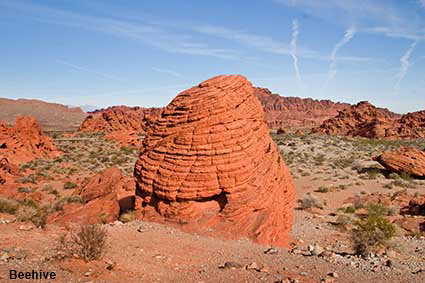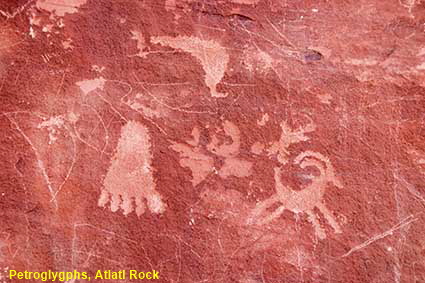Valley of Fire State Park
When visitors to Las Vegas need a break from the city and its casinos, a common trip is to the Red Rock Canyon just outside the city. While Red Rock Canyon is OK, if you want to see some really good red rocks there is a far better place 75 kilometres (47 miles) north east of Vegas. Valley of Fire State Park is full of red sandstone formed from sand dunes that existed 150 million years ago in the time of the dinosaurs. The State Park was set up in 1935 and its name reflects the vibrant red rock formations, so bright that on sunny days the rocks appear almost to be burning.
Mouse's Tank
These are desert lands with sparse rainfall so water is in short supply. Natural basins in the rock can accumulate water during rain providing a welcome source of water that can last for months. Mouse’s Tank is named after a renegade Indian who used this area as a hideout in the 1890's
Petroglygphs, Atlatl Rock
These ancient Indian petroglyphs are high up on Atlatl rock, but the State Park has built a metal staircase to allow visitors to see them close up. The rock has been named after the atlatl, a notched stick used by the ancient Indians to launch a spear at their prey.
Arch Rock
Apart from its distinctive brilliant red rocks Valley of Fire has shaped rocks, petroglyphs, petrified logs, water tanks and rock arches. The arches can’t compete with Arches National Park in Utah nor can the petrified logs compete with Petrified Forest National Park in Arizona. That is part of the charm of Valley of Fire, it offers you a little bit of everything.
Beehive
Perhaps one of the best examples of erosion in the park is these unusual sandstone formations. Erosion has left these rocks standing proud of the surrounding land, and weathering by the forces of wind and water has created a pattern of cracks that gives them an appearance reminiscent of an old fashioned beehive.
Click on Minimap to navigate




DLU080227


To move forwards or backwards through the Nevada trail click the arrows above, or select your next destination on the Minimap.


© Mike Elsden 1981 - 2025
The contents of this page may not be reproduced in full or in part without permission